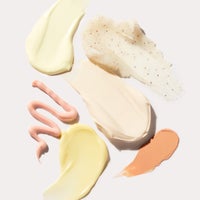
If you're someone who feels like you have patches of sandpaper all over your skin, you can probably relate to the other 3 million Americans that feel the same way. These annoying, hard, acne-like bumps appearing on your skin are a condition known as Keratosis Pilaris.
What is Keratosis Pilaris?
Let's look at the silver lining here. Fortunately, these little bumps are harmless. They are, however, a disorder of the keratinization of the skin cells. This condition usually peaks in adolescence and fades into adulthood, and while it may look like acne, those scaly, red bumps are actually clogged hair follicles.
How skin works
As the skin develops, new layers make their way up from the "basement" layer of the skin and as they get closer to the epidermis, or outer layer of skin, the layers die and undergo a hardening process called keratinization. This process helps the cells form keratin proteins that help waterproof the layers as new ones develop.
In a normal, healthy layer of skin, these dead cells are washed away as new ones replace them, but in the case of Keratosis Pilaris, these hardened, dead skin cells build up on the epidermis and plug the opening of the hair follicles. Inevitably, this is what causes the white and/or red bumps on your skin.
What causes Keratosis Pilaris?
A number of things could be causing the disorder—anything from hormonal imbalances to genetics.
Genetics
Everything is written in your genes. Yes, this also includes any health malfunctions you may be more prone to. When a genetic mutation occurs, even if it's just one, it can have an effect on multiple functional processes throughout the body. In the case of Keratosis Pilaris, there is a certain genetic mutation that occurs in the gene regulating proliferation of skin cells and proteins.
Chances are, if one of your parents has this, there's a strong likelihood that you'll be in for the same ride as well.
Hormonal imbalances
While this disorder occurs in both men and women, believe it or not, females are more likely to pay the higher price. Women that display hormonal disturbance or estrogen dominance are more likely to develop this disorder. Specifically, pregnant women that are going through a colossal amount of hormone changes may be more affected by this disorder.
Skin allergies
Keratosis Pilaris is associated with and found to be aggravated by many other skin conditions like eczema and other allergic skin disorders. Usually, once the underlying skin condition is treated, outbreaks of Keratosis Pilaris can lessen, though it does not eliminate them entirely.
Vitamin A deficiency
When you were told to eat your veggies as a kid, they were onto something. The health benefits you can gain from your spinach and carrots have a lot more to offer than just a full stomach. The vitamin takes a lot of the credit in regulating your skin's proliferation process and helps prevent hyperkeratinization that causes the skin to become very dry, scaly and rough.
How to Treat Keratosis Pilaris
Sadly, there isn't anything you can do to "get rid" of Keratosis Pilaris, but there are things you can do to lessen its effects.
Don't scratch
One of the worst things you could do to those irritated patches of dry skin is to irritate them more. Just like chicken pox, don't scratch or rub them roughly. This will only make them worse.
No hot showers
We're not saying you need to take arctic-worthy temperature showers, but you should limit your skin's exposure to intense heat, as this only dries it out more. Opt for a more lukewarm water temperature as this will have less likelihood of stripping your skin of essential moisture.
Use a moisturizing soap
This isn't lost on us. We know what the harsh detergents in bathroom soaps do to our hands, but not all soaps are that way! Switch out your usual liquid soap for one with soothing, moisturizing ingredients like aloe vera or shea butter.
Nourishing lotions and body creams are your friends
Are you noticing a pattern here? Your skin needs moisture. Keeping your skin well hydrated will help the regression of your Keratosis Pilaris.
Your skin may be red and patchy, but it doesn't have to stay that way! There is relief. Give your skin the love it needs and it will love you back.
Discover more moisturizing creams and soaps on our SkinStore website here.
| Love Skincare? discover our edit of how to treat scalp bumps. |









